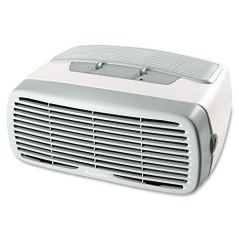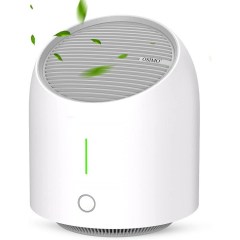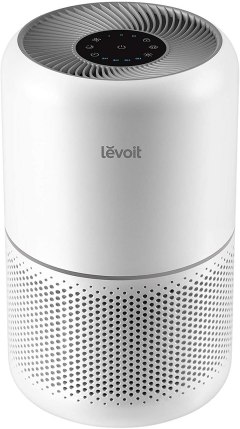BestReviews is reader-supported and may earn an affiliate commission. Details

This air purifier earns marks with our home improvement expert and customers for its built-in aromatherapy diffuser.
Distribute pleasant fragrances through the unique aromatherapy system. Carbon filtration system removes dust, pollen, and other common irritants. Features a convenient display light that can be turned off.
Purifier gets clogged easily, which can be frustrating to clean.

We appreciate the affordable price of this compact air purifier, as well as its compatibility with different types of filters.
Filters particles as small as 2 microns. Accommodates a variety of Holmes filter types. Coverage up to 109 square feet. Works in both orientations. Fan has 3 speed settings. Optional ionizer available.
Some complaints about noisy operation. Can leave residue on walls.

Our expert recommends the OSIMO for its ability to remove dust through its home HEPA filters.
Features a 3-stage filtration system to thoroughly remove impurities: pre-filter, true HEPA, and activated carbon. Covers a large amount of space. Offers 3 different settings depending on your personal needs.
Package does not come with a charger or accessories, so users will have to purchase their own.

This compact, affordable air purifier exceeded expectations in our user testing.
Compact purifier for bedrooms and other spaces of 219 square feet. Fits on night stands or bedside tables. Noticeably reduced smoke and odors in our testing. Has 4 different options in filters. Quiet, dimmed sleep mode.
Not at its best in larger spaces. Controls a little confusing in testing.

A great overall air purifier, but pet owners may benefit most from its odor-trapping filtration system.
HEPA filter designed for long-term use. Includes 2 carbon zeolite filters for pet odors. Effective range up to 140 square feet. Works in vertical or horizontal positions. Captures particles as small as 3 microns.
Fan is noisy. Exhaust port close to air intake; not an efficient design.

We recommend these products based on an intensive research process that's designed to cut through the noise and find the top products in this space. Guided by experts, we spend hours looking into the factors that matter, to bring you these selections.

In our crowded world, air purifiers are becoming increasingly necessary for environmental comfort at home and at work. Allergies and sensitivity to smoke and other airborne things can make some people just plain miserable. Even those who don’t have allergies want and deserve clean, fresh air to breathe.
An air purifier that costs under $50 can offer many of the same benefits of a larger, more expensive unit, depending on your space and health issues. They are a boon to apartment dwellers who don’t have a choice as to what filtration system is used for air conditioning or forced-air heating. They can even be palm-sized units that provide discreet air purification in an office or car. What’s more, many of today’s low-cost air purifiers are much quieter than ever before.
Still, it’s not enough to just grab any air purifier. Which type would work for your situation? Keep reading our guide to the best air purifiers under $50 to learn about the options and possibilities.

Air purifiers under $50 may have limitations that their pricier counterparts do not. For example, few air purifiers in this price range have advanced features such as ionizers, UV light sanitizers, and essential oil diffusers. Those that do offer these options may have limited effectiveness.
However, many air purifiers under $50 do a fantastic job clearing the air of dust, pollen, and most pet dander. They can also help diminish odors in your space, and some reduce the impact of irritating cigarette smoke as well.
The key to effective air purification is to select the right features for your situation. If you have allergies to pollen, pet dander, or dust, a HEPA filter is a must-have. If odors from cooking or smoking are the issue, look for a unit with an activated carbon filter. If you’re worried about viruses or bacteria in the air, an electrostatic or ionic purifier may provide a degree of protection. We’ll go over these features in the next section.
While air purifiers under $50 can be a fantastic deal, their physical range of effectiveness tends to be limited compared to larger air purifiers. Expect a unit in this price range to clean the air in spaces of 300 square feet or less. You may later decide to buy more than one low-cost unit and position them throughout your home.
A low-cost air purifier may have one fan speed or several. Even with multiple speeds, however, fan power could be an issue. On the other hand, the fan of a machine like this will likely run quieter than the fan of a large machine.
Carbon and HEPA filters must be changed regularly, and they aren’t necessarily cheap. This is an issue not just with low-cost air purifiers, though. Regardless of which filter you buy, you should anticipate added filter replacement costs.
As mentioned, consumers with allergies to pet dander as well as dust mites and pollen would do well with a HEPA filter. Notably, HEPA filters cannot filter out everything. Viruses, larger mold spores, and other microorganisms may still pass through. Further, it is possible for mold to actually grow on a HEPA filter. For this reason, we advise consumers to invest in the highest-quality air purifier (and filtering system) possible.
In air purifiers with electrostatic capability, the plates used to create the electrostatic charge quickly get gummy and dirty. They must be cleaned as frequently as every three days, or they won’t work well.
Ionic air purifiers generate larger amounts of ozone than other types of air purifiers. For most people, they do not create enough ozone to cause health problems, but the Mayo Clinic warns that people with asthma or severe allergies may actually experience a reaction near an ionizer.

Differences exist between various filter materials. Let’s take a look at what you might choose when shopping for an air purifier.
Carbon filter: If odors are an issue in your home, a carbon filter is a must. The activated carbon in these filters absorbs organic compounds (the molecules that cause odor).
HEPA filter: These filters are made of fine glass threads less than 1 micron thick (about 1/75 the thickness of a human hair), woven (or really, tangled) together to create a filter mat with openings less than 0.5 micron wide. As we have mentioned, HEPA filters are ideal for trapping very small particles including pollen, smoke, and micro-particulates.
Electrostatic precipitator: This type of filter traps the tiniest particles (as small as 0.01 microns) by creating a cloud of free ions (both positive and negative) within the air purifier that charge particles as they pass through the cloud. Then they’re trapped on the precipitator’s steel plates.
Ionic: An ionic filter creates a small amount of static electricity surrounding the unit to actively charge dust and organic compounds, so they fall to the floor rather than float around. An ionizer can help reduce odors from smoke and cooking but is not as efficient as a HEPA filter at trapping dust, pollen, and dander.
Air purifiers have two to three layers of filtration to trap as many particles as possible, from visible to microscopic.
Pre-filter: A pre-filter sponge or layer traps larger particles of dust, pollen, and dander before they reach the air purifier’s HEPA filter. This layer can drastically extend the life and performance of the filtration system, as those large particles would otherwise quickly clog the super-fine mesh of the HEPA filter. They can usually be cleaned, or cheaply replaced, making them a cost-effective feature.
Main filter: The center layer is designed to trap the smallest particles. In a direct airflow system, this is usually a HEPA filter. In systems that charge particles, this is where the electrostatic plates or the ionizer reside.
Post-filter: A third filtration option after air passes through the pre-filter and main filter, the post-filter may contain activated carbon to absorb odors. It provides extra filtration and is helpful when the main filter or electrostatic plates fill with particles.
Some air purifiers have a small receptacle on the outside cabinet of the unit with a sponge. On this sponge, a few drops of essential oil can be placed. The scent is then wafted through the room on the air current created by the purifier fan’s outflow. In theory, an aroma diffuser is a great addition. However, if your air purifier includes a carbon filter, it will simply absorb the aroma before it diffuses too widely through the room, limiting its effectiveness.
Ultraviolet light can kill viruses and bacteria if it is powerful enough. Effective UV lights are expensive, so don’t expect to see them in a sub-$50 air purifier. You can also purchase UV sanitizers for your shoes.
If you want to run your air purifier for a set period of time, a timer can be a helpful addition. Limiting or tailoring the amount of time you run your machine can help save money on your electricity bill and prolong the life of the air filter.
If you want an aromatherapy option, the oil diffuser unit must be located at the air purifier’s outlet as far from its intake as possible. Otherwise, the aroma will just be absorbed by the carbon pre-filter.
Lagunamoon Essential Oils Gift Set
For an air purifier with an essential oil diffuser, placing a few drops of therapeutic-grade oil into the receptacle can help bring calm, focus, and energy to a room. This gift set includes popular scents like lavender, lemongrass, orange, and eucalyptus.
Fresh Headquarters Cut-to-Fit Carbon Pad Pre-Filter Roll
cost-effective replacement alternative for an air purifier’s pre-filter, this carbon pad absorbs odors and traps larger particles.
Germ Guardian HEPA Air Purifier Replacement
Pricey but necessary if you suffer from allergies, HEPA filter replacements like this one are shaped for specific air purifiers. Check the manual for exact replacement sizes.
Mini and compact air purifiers, many of which plug directly into a wall or USB outlet, offer a highly portable air purifying experience and can be found for $7 to $18. You’ll have to look carefully for one with a HEPA filter, though.
Desktop-size purifiers rule the mid-range category and have additional options like timers and aromatherapy diffuser ports. These products range from $19 to $38.
While the size of air purifiers in the $39 to $49 range is only slightly greater than that of mid-range models, they offer the best air purification in the sub-$50 market with three-in-one filtration systems including HEPA and activated carbon filters.


A. Activated oxygen is a savvy marketing term for ozone. Because too much ozone has negative health effects, it has become a word that consumers watch for in product labeling. So “activated oxygen” became an alternate term for ozone. In air purifiers with either electrostatic or ionic filter systems, ozone is one product created when oxygen (O2) passes through the cloud of charged particles. Another ion may attach to the oxygen atom so that it becomes O3, also known as ozone. Ignore the marketing language and look for information on the amount of ozone the filter creates.
On the plus side, small air purifiers under $50 rarely have ionic or electrostatic systems, and if they do, the amount of ozone created is negligible and harmless for most users.
A. Cat dander particles vary in size, with about two-thirds measuring 5 to 10 microns and one-third measuring less than 2.5 microns. They’re tiny and easy to aerosolize (fly up in the air and float around, basically), and they settle on absolutely everything. An air purifier with a HEPA filter is the best choice, but it will not completely clear a room of dander and other allergens (that’s almost impossible outside of a sealed lab). Still, it will make a huge difference in air quality.
A. Besides being more affordable and potentially easier to clean and maintain, you can customize and localize the placement of a smaller air purifier to optimize effectiveness. For example, a desktop-size air purifier can be placed next to your desk, where you may spend much of your day. Because it’s portable, you can shift the location of a smaller unit to stay next to you throughout your home. Alternately, you could purchase multiple small air purifiers and set them up throughout a room or house to trap more particles than a single large unit might.
A. Sadly, no. Consider an air purifier as a component of the allergen prevention strategy you have in your home. Dust, vacuum, and mop your home as usual, taking any needed allergy precautions (such as wearing a filter mask and non-allergenic gloves while cleaning). The air purifier helps further improve air quality.
Get emails you’ll love.
Learn about the products you’re wondering if you should buy and get advice on using your latest purchases.
